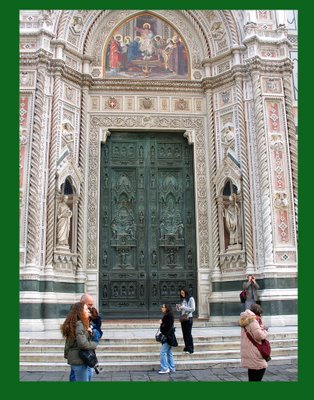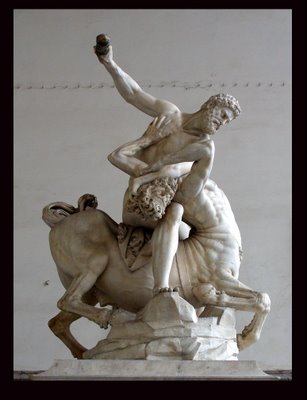 FLORENCE even on a rainy, autumn day is more fascinating than most cities in the world on their best days. Perhaps Santa Croce and the Duomo can be considered twice beautiful reflected in a rain-slick piazza. Maybe the colors of the buildings on the Ponte Vecchio are more saturated and richer when wet. At any rate, that's how we experienced the city this time. The rain didn't matter. The Ponte Vecchio photographs below were shot about three o'clock in the afternoon in a light rain. Night came on early because of the low clouds. Earlier the sun was shining when we were at the cathedral, but then the sky darkened and the sun disappeared for the rest of the day.
FLORENCE even on a rainy, autumn day is more fascinating than most cities in the world on their best days. Perhaps Santa Croce and the Duomo can be considered twice beautiful reflected in a rain-slick piazza. Maybe the colors of the buildings on the Ponte Vecchio are more saturated and richer when wet. At any rate, that's how we experienced the city this time. The rain didn't matter. The Ponte Vecchio photographs below were shot about three o'clock in the afternoon in a light rain. Night came on early because of the low clouds. Earlier the sun was shining when we were at the cathedral, but then the sky darkened and the sun disappeared for the rest of the day. 
 SANTA MARIA DEL FIORE
SANTA MARIA DEL FIOREApparently size matters. Depending on which way you take the measurements, in all of Christendom, the Cathedral of Santa Maria del Fiore (The Duomo) is exceeded in size only by St. Peter's in Rome. According to one source, I found that St. Peter's in Rome is the largest, The Duomo in Florence is second. St. Paul's in London is third, and St. Genevieve in Paris is fourth. According to another source, St. Peter's is first, St. Paul's is second, the Duomo in Milan is third, and the Duomo in Florence is fourth. The first author was comparing domes. The second was comparing length's and widths. Anyway you look at it, the Cathedral in Florence is immense and impressive.
By the 13th Century Florence had become one of the wealthiest cities in the civilized world and the great architect Arnolfo di Cambio was hired to design the project. He died before he could complete his masterpiece. In the middle of the 14th Century Giotto di Bondone was put in charge and he concentrated on designing and building the Campanile. The Duomo remained unfinished through the first half of the 15th Century. Everybody agreed that a big dome was important, but nobody could come up with a way to build one as big as they wanted. Along came Brunelleschi with a solution. He designed an inner and an outer shell. After much trial and error, the dome was completed in 1436.
The Cathedral, the Baptistry, and the Campanile fill the piazza. It's interesting to speculate what the effect of the building might be if it were surrounded by open space.






You might expect the stunning sculptures at THE PALAZZO DELLA SIGNORIA and the LOGGIA DEI LANZI to be kept behind museum walls; but there they are, out in the open for everybody to enjoy. Michelangelo's David was long ago moved from this spot to the Galleria dell'Accademia to prevent further damage from polution. The Accademia no longer allows photographs of the Michelangelo sculptures, but even the copy of The David in the Palazzo is impressive. It's hard to pick a favorite, but I guess I have to go with Benvenuto Cellini's "Perseus." The story behind the casting of this fine sculpture is almost as good a the work itself. I'm not going to include it here, but the story is worth searching out if you're interested.
I guess my second and third favorites are "Hercules and the Centaur" and "the Rape of the Sabines."







We ended the day in Florence back at Santa Croce. It was almost dark, a light rain was falling, but the light was perfect for a timed exposure. I got this photograph from the steps in front of the church.

No comments:
Post a Comment